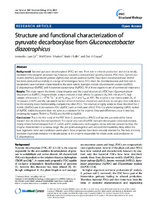Structure and functional characterization of pyruvate decarboxylase from Gluconacetobacter diazotrophicus
Date
2014Author
van Zyl, Leonardo Joaquim
Schubert, Wolf-Dieter
Tuffin, Marla I.
Cowan, Donald A.
Metadata
Show full item recordAbstract
BACKGROUND: Bacterial pyruvate decarboxylases (PDC) are rare. Their role in ethanol production and in bacterially
mediated ethanologenic processes has, however, ensured a continued and growing interest. PDCs from Zymomonas
mobilis (ZmPDC), Zymobacter palmae (ZpPDC) and Sarcina ventriculi (SvPDC) have been characterized and ZmPDC
has been produced successfully in a range of heterologous hosts. PDCs from the Acetobacteraceae and their role in
metabolism have not been characterized to the same extent. Examples include Gluconobacter oxydans (GoPDC),
G. diazotrophicus (GdPDC) and Acetobacter pasteutrianus (ApPDC). All of these organisms are of commercial importance.
RESULTS: This study reports the kinetic characterization and the crystal structure of a PDC from Gluconacetobacter
diazotrophicus (GdPDC). Enzyme kinetic analysis indicates a high affinity for pyruvate (KM 0.06 mM at pH 5), high
catalytic efficiencies, pHopt of 5.5 and Topt at 45 degrees C. The enzyme is not thermostable (T of
18 minutes at 60 degrees C) and the calculated number of bonds between monomers and dimers do not give clear indications
for the relatively lower thermostability compared to other PDCs. The structure is highly similar to those described for Z.
mobilis (ZmPDC) and A. pasteurianus PDC (ApPDC) with a rmsd value of 0.57 A for C? when comparing GdPDC to that
of ApPDC. Indole-3-pyruvate does not serve as a substrate for the enzyme. Structural differences occur in two loci,
involving the regions Thr341 to Thr352 and Asn499 to Asp503.
CONCLUSIONS: This is the first study of the PDC from G. diazotrophicus (PAL5) and lays the groundwork for future
research into its role in this endosymbiont. The crystal structure of GdPDC indicates the enzyme to be evolutionarily
closely related to homologues from Z. mobilis and A. pasteurianus and suggests strong selective pressure to keep the
enzyme characteristics in a narrow range. The pH optimum together with reduced thermostability likely reflect the
host organisms niche and conditions under which these properties have been naturally selected for. The lack of activity
on indole-3-pyruvate excludes this decarboxylase as the enzyme responsible for indole acetic acid production in
G. diazotrophicus.

